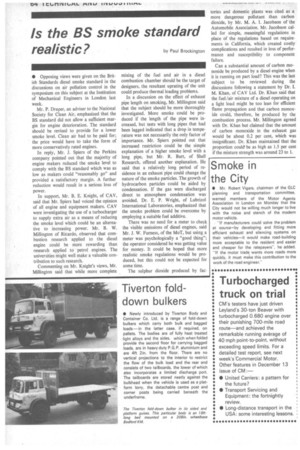Is the BS smoke standard realistic?
Page 66

If you've noticed an error in this article please click here to report it so we can fix it.
by Paul Brockington • Opposing views were given on the British Standards diesel smoke standard in the discussions on air pollution control in the symposium on this subject at the Institution of Mechanical Engineers in London, last week.
Mr. P. Draper, an adviser to the National Society for Clean Air, emphasized that the BS standard did not allow a sufficient margin for engine deterioration. The standard should be revised to provide for a lower smoke level. Clean air had to be paid for; the price would have to take the form of more conservatively rated engines.
In reply, Mr. J. Spiers of the Perkins company pointed out that the majority of engine makers reduced the smoke level to comply with the BS standard which was as low as makers could "reasonably go" and provided a satisfactory margin. A further reduction would result in a serious loss of power.
In support, Mr. B. E. Knight, of CAV, said that Mr. Spiers had voiced the opinion of all engine and equipment makers. CAV were investigating the use of a turbocharger to supply extra air as a means of reducing the smoke level which could be an alternative to increasing power. Mr. B. W. Millington of Ricardo, observed that combustion research applied to the diesel engine could be more rewarding than research applied to petrol engines. The universities might well make a valuable contribution to such research.
Commenting on Mr. Knight's views, Mr. Millington said that while more complete mixing of the fuel and air in a diesel combustion chamber should be the target of designers, the resultant uprating of the unit could produce thermal loading problems.
In a discussion on the effect of exhaust pipe length on smoking, Mr. Millington said that the subject should be more thoroughly investigated. More smoke could be produced if the length of the pipe were increased, but tests with long pipes that had been lagged indicated that a drop in temperature was not necessarily the only factor of importance. Mr. Spiers pointed out that increased restriction could be •the simple explanation of a higher smoke level with a long pipe, but Mr. R. Burt, of Shell Research, offered another explanation. He said that a relatively long period of residence in an exhaust pipe could change the nature of the smoke particles. The growth of hydrocarbon particles could be aided by condensation. If the gas were discharged direct to atmosphere condensation was avoided. Dr. E. P. Wright, of Lubrizol International Laboratories, emphasized that the smoke problem could be overcome by employing a suitable fuel additive.
There was no need for a meter to check the visible emissions of diesel engines, said Mr. J. W. Furness, of the MoT, but using a meter was psychologically a "good thing"; the operator considered he was getting value for money. It could be hoped that more realistic smoke regulations would be produced, but this could not be expected for some time.
The sulphur dioxide produced by fac
tories and domestic plants was cited as a more dangerous pollutant than carbon dioxide, by Mr. M. A. I. Jacobson of the Automobile Association. Mr. Jacobson called for simple, meaningful regulations in place of the regulations based on requirements in California, which created costly complications and resulted in loss of performance and susceptibility to component failure.
Can a substantial amount of carbon monoxide be produced by a diesel engine when it is running on part load? This was the last subject to be reviewed during the discussions following a statement by Dr. I. M. Khan, of C A V Ltd. Dr. Khan said that the fuel /air mixture of a diesel operating on a light load might be too lean for efficient flame propagation and that carbon monoxide could, therefore, be produced by the combustion process. Mr. Millington agreed with Dr. Khan but claimed that the amount of carbon monoxide in the exhaust gas would be about 0.2 per cent, which was insignificant. Dr. Khan maintained that the proportion could' be as high as 1.5 per cent if the mixture strength was around 23 to 1.








































































































































































